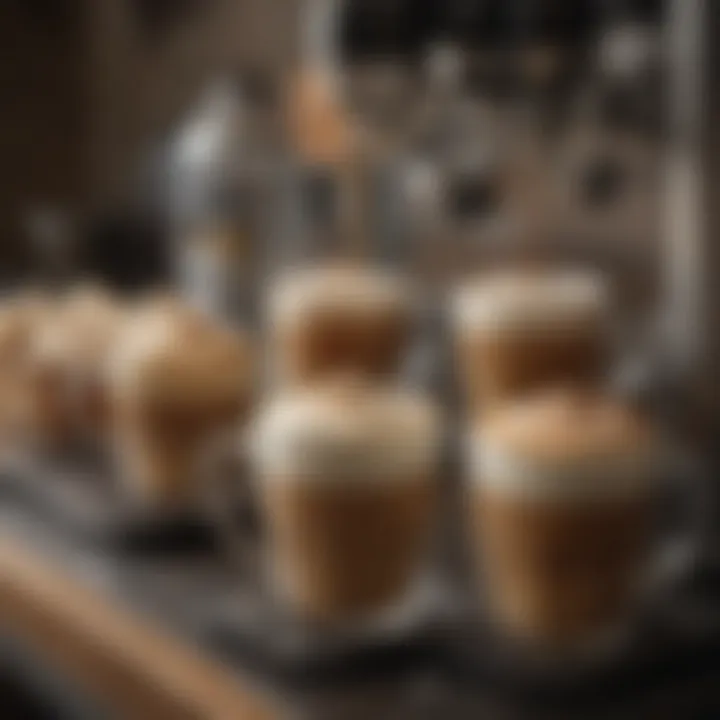Mastering the Art of Home Latte Making


Intro
Home latte making has gained popularity among coffee enthusiasts who seek to replicate the café experience without leaving their kitchens. Understanding the intricacies of creating a perfect latte dal experience is essential. This journey entails selecting the right equipment, mastering techniques, and balancing ingredient quality.
In this article, you will explore various latte makers available, from simple manual frothers to sophisticated machines. The guide will also delve into the nuances of milk frothing, the significance of using high-quality coffee beans, and how these elements contribute to crafting delightful lattes.
As we engage with this topic, busy professionals, home cooks, and food lovers will discover practical insights tailored to elevate their coffee-making skills. Whether you are a beginner or looking to refine your technique, this comprehensive guide will equip you with knowledge and methods to enjoy gourmet coffee at home, all while optimizing your time and effort.
Understanding the Appeal of Homemade Lattes
The growing trend of homemade lattes reflects a deeper appreciation for coffee culture and the crafts of brewing. Understanding this appeal is essential for anyone looking to embrace latte making, whether they are professionals seeking knowledge or enthusiasts eager to refine their skills. Homemade lattes provide several advantages, from cost savings to creative freedom.
Why Choose a Latte Maker
A latte maker can significantly enhance the quality of coffee brewed at home. Having dedicated equipment allows for better extraction of flavors from high-quality coffee beans. With options ranging from manual devices to complex machines, selecting the right latte maker depends on individual preferences and the desired level of involvement in the brewing process. It offers precision in both brewing and frothing, which are critical for creating a quality latte. By investing in a latte maker, one gains not just a tool, but an entry point into a world of beverages that can rival a café.
Cost Efficiency of Brewing at Home
Brewing lattes at home can be more economical than frequently buying from coffee shops. The initial costs of a good latte maker and quality coffee beans may seem high, but they lead to significant savings in the long run. For example, consider that an average café latte costs about $4, while making one at home may only cost $1 or less, based on ingredients and energy use. This saving increases for those who enjoy multiple lattes each week.
- Ingredient Expenses: High-quality coffee beans and milk can be purchased in bulk.
- Initial Investment: One-time purchase of a latte maker can lead to repeated savings.
- Convenience: No need to travel to a café or wait in line, representing both time and money savings.
Customization and Flavor Control
One of the most compelling reasons to make lattes at home is the level of customization available. Home brewers can choose everything from the type of coffee used to the frothing technique. This flexibility allows individuals to experiment with flavors, textures, and presentations. Some key elements of customization include:
- Bean Selection: Choose specific coffee types for distinct flavor profiles.
- Milk Choices: Use dairy or non-dairy options according to preference.
- Sweeteners and Spices: Control sweetness and flavors down to the exact quantities.
"Home latte making is not just a practice; it is an art form that transforms coffee into a personal experience."
Types of Latte Makers
Understanding the different types of latte makers is crucial for anyone eager to elevate their home coffee experience. The choice of a latte maker can significantly influence the brewing process, taste, and overall quality of your homemade lattes. Each type of machine offers distinct features that cater to various preferences and skill levels. When selecting a latte maker, consider factors such as ease of use, personal skill level, and the degree of control you want over the brewing process.
Manual Latte Makers
Manual latte makers provide an engaging experience for those who enjoy a hands-on approach to coffee making. These machines often require physical effort to brew espresso, which can enhance the appreciation for the crafting process. A popular option in this category is the Moka pot, which consists of a simple design that brews coffee through steam pressure. The outcome is strong coffee, suitable for creating authentic lattes.
Benefits of manual latte makers include:
- Affordability: Generally more cost-effective than automatic machines.
- Simplicity: Fewer mechanical parts can mean less potential for breakdowns.
- Customization: Allows control over variables like water temperature and extraction time.
However, the downside is that producing a consistent result may take time and practice.
Semi-Automatic Latte Machines
Semi-automatic latte machines strike a balance between user control and automation. These devices handle the water pressure during brewing but still require the user to grind the coffee and froth the milk manually. This type of machine can be ideal for those who want to learn the basics of espresso extraction while still benefiting from some automated functions.
Some notable advantages include:
- Flexibility: Users can experiment with different grind sizes and brewing times.
- Quality: Many semi-automatic machines come with higher-quality components than manual options, usually yielding better espresso.
One consideration is that these machines can be moderately expensive, and users must invest time to master the different elements.
Fully Automatic Espresso Machines
Fully automatic espresso machines epitomize convenience in the latte-making process. These machines automate the entire brewing cycle, from grinding the beans to frothing the milk, delivering a consistency that appeals to busy individuals. Brands like De'Longhi and Breville lead the market with models that cater to various budgets and preferences.
Key benefits of fully automatic machines include:
- Ease of Use: One-touch controls allow anyone to brew quality lattes effortlessly.
- Consistency: Automated features help maintain the same taste and quality in every cup.
- Built-in Accessibility: Many models have integrated grinders, reducing the need for additional equipment.
However, the price point can be a barrier for some.
Stovetop and French Press Options
For those who prefer traditional methods, stovetop espresso makers and French presses offer unique alternatives to craft lattes. Stovetop brewers, like the Bialetti Moka pot, are similar to manual makers but utilize the stovetop for heating water. They provide a simple way to brew robust coffee from the comfort of your kitchen.
On the other hand, French presses are versatile and can produce a richer coffee body due to the brewing process. Both methods require minimal investment, making them ideal for casual coffee drinkers. While these methods may not replicate the espresso shot from an espresso machine, they can still create satisfying coffee bases for lattes.
Essential Components for Making Lattes
The essence of crafting a delicious latte lies not just in the brewing process or the equipment used, but significantly in the quality of the ingredients. This section delves into the essential components which include quality coffee beans, fresh milk selection, and sweeteners and flavor additions. Each element plays a distinct role in developing a robust and flavorful latte, making them critical to the overall experience.
Quality Coffee Beans
Quality coffee beans are the foundation of a good latte. The type of coffee bean influences the taste, aroma, and body of the latte. Arabica beans are often favored for their smooth, complex flavors, while Robusta beans provide a stronger, bolder taste and more caffeine.


When selecting coffee beans, consider the roast level. Medium roasts offer a balance between acidity and sweetness, making them ideal for lattes. Dark roasts can add a bold flavor but may overshadow the milk, while light roasts can bring out fruity and floral notes.
To ensure the freshest taste, buy beans that are whole and grind them just before brewing. This preserves the essential oils and flavors that could degrade over time. Investing in high-quality beans can make a significant difference, transforming a simple latte into a gourmet experience.
Fresh Milk Selection
The selection of milk is equally vital for making lattes. Different types of milk can alter the texture and flavor of the drink. Whole milk is often preferred for its creaminess and ability to create a rich foam. However, alternatives like oat milk, almond milk, or soy milk are gaining popularity. Each type of milk has its unique qualities:
- Whole Milk: Provides the richest foam and flavors.
- Oat Milk: Creamy, with a slightly sweet taste.
- Almond Milk: Provides a light, nutty flavor but may froth less effectively.
- Soy Milk: Offers a good balance but can curdle if heated too much.
Selecting fresh, high-quality milk is essential. Avoid pre-packaged milk that has been sitting on shelves for extended periods. Instead, opt for locally sourced products when possible. This ensures a fresher taste and supports local producers.
Sweeteners and Flavor Additions
Sweeteners and flavor additions provide an opportunity to tailor your latte to personal taste. Common sweeteners include sugar, honey, or agave syrup. Each option brings its flavor profile, allowing for customization. Additionally, flavored syrups can enhance the latte experience:
- Vanilla Syrup: Adds warmth and sweetness, complementing the coffee.
- Caramel Syrup: Creates a rich, indulgent flavor.
- Hazelnut Syrup: Provides a nutty, aromatic twist.
Apart from sweeteners, consider incorporating spices like cinnamon or nutmeg for added depth. You might also experiment with extracts like peppermint or almond. Always remember that a little goes a long way; minor additions can significantly impact.
In summary, focusing on the essential components—quality coffee beans, fresh milk selection, and thoughtful flavor additions—sets the stage for an exceptional latte experience.
By carefully selecting each ingredient, you ensure a superior product that leads to satisfaction with every sip. This attention to detail in the fundamental components is what elevates home latte making from a mundane task to an art form.
The Brewing Process
The brewing process is a critical phase in crafting a latte at home. It defines the overall quality and experience of the final product. Mastering this step involves understanding the precise methods that elevate your latte from mere coffee to a delightful gourmet experience. The focus here is on three crucial elements: grinding coffee beans, determining the ideal brew time, and employing proper measurement techniques. Each aspect contributes significantly to the depth of flavor and consistency in your beverage.
Grinding Coffee Beans
Grinding coffee beans is one of the most fundamental steps in the brewing process. Freshly ground coffee offers optimal flavor extraction, which can dramatically enhance the quality of your latte. It’s important to use a burr grinder, as it produces a more uniform grind compared to blade grinders. This uniformity ensures that water can extract flavors evenly from the coffee grounds.
Consider the grind size. For lattes, a medium to fine grind often works best. Too coarse, and the coffee will be under-extracted, resulting in a weak and acidic taste. Conversely, too fine a grind can lead to over-extraction, which creates a bitter flavor.
Determining Ideal Brew Time
Timing is crucial when brewing coffee. The ideal brew time for lattes typically hovers between 25 to 30 seconds. This duration allows for the perfect extraction of flavors from the coffee.
If the brew time is too short, the result will yield a sour taste, as not enough oils and flavors will be extracted from the coffee grounds. If the brew time exceeds 30 seconds, the espresso may become too bitter due to over-extraction.
Adjusting brewing times can take some practice, but it is an essential skill for producing lattes with depth and richness.
Proper Measurement Techniques
Correct measurements in ingredients are essential for maintaining consistency in each cup of latte. This pertains to both coffee grounds and water. Generally, the ideal ratio is about 1:2, meaning one part coffee to two parts water. A precise kitchen scale can facilitate accurate measurements, ensuring that you are using the right amount every time.
Moreover, water quality also deserves attention. Filtered water is recommended to avoid any off-flavors that can interfere with the taste of your brew.
Remember: Consistency in your brewing process leads to better results. Track what works best for you and adjust as necessary.
By mastering the brewing process, you set the foundation for the perfect homemade latte. Each element – from grinding to timing and measuring – plays a vital role in crafting a high-quality coffee experience in your kitchen.
Frothing Techniques
Frothing techniques are crucial in the art of home latte making. The quality of frothed milk greatly impacts the taste and overall experience of the drink. Good froth provides a creamy texture and enhances the flavors of the coffee. Learning the proper way to froth milk is essential for any aspiring home barista. This section will explore the various methods of frothing milk, helping you master this skill.
Understanding Milk Frothing
Milk frothing involves adding air into hot milk to create a light, fluffy texture. There are several factors affecting the quality of frothed milk. The type of milk used is significant; whole milk creates a richer froth while skim milk produces a lighter foam. Additionally, the milk's temperature should be around 150-155°F (65-68°C) for optimal frothing. Heating the milk too much can scorch it, ruining the flavor. Conversely, colder milk will not froth properly. Proper frothing enhances the latte’s visual appeal and contributes to the final flavor profile.
Utilizing a Steam Wand
The steam wand is a popular choice for frothing milk among home baristas. It heats milk while creating the ideal microfoam. To use a steam wand effectively, insert the wand at an angle just below the surface of the milk. Engaging the steam should initially create bubbles. After a few seconds, lower the wand deeper into the milk and position it to create a whirlpool effect. This motion helps dissolve larger bubbles into smaller ones, resulting in a smooth, velvety texture. Remember to always clean the wand after use to maintain hygiene and ensure consistent performance in future uses.
Alternative Frothing Tools
For those without a steam wand, there are several alternative frothing tools available. French presses, for instance, can be a handy frothing tool. Pour heated milk into the press, then pump the plunger using quick motions to create bubbles. Electric frothers are another popular option. These devices assist in quickly creating foam by whisking the milk. Manual frothers require more effort but enable control over the frothing process, allowing for personal preferences in texture.
Consider that the frothing method you choose significantly influences your latte's outcome. Experimentation may lead to discovering your unique frothing technique that suits your taste.
Building Your Latte
Creating a latte is not just about brewing coffee and steamng milk. It is a careful process that highlights both creativity and precision. The section on building your latte discusses important components that play a vital role in achieving the best results. It covers techniques, the importance of presentation, and personal touches that can elevate a simple cup into an experience.
Pouring Techniques
Pouring is an art that requires practice and understanding. The angle and speed at which you pour the steamed milk can significantly influence the final presentation of the drink. Begin by holding the cup at a slight tilt. This helps in maintaining control over the flow of milk. Start pouring from a higher distance to allow the milk to mix gently with the espresso. Avoid pouring directly in the center at first. Instead, pour towards the side of the cup. As the cup fills, lower your pouring position and gradually direct the stream towards the center. This technique promotes an even combination of espresso and milk, creating a well-balanced flavor.
Experiment with different pours. A slow and steady pour results in a velvety texture. However, a quick pour can yield a lighter foam. Understanding these techniques leads you to explore various ways to create depth in your latte. The flow of milk can be controlled to produce layered effects.


Creating Latte Art
Latte art serves as the finishing touch that transforms a latte into a visual treat. The latte art is more than mere decoration; it reflects the skill of the maker. To create art, a good frothed milk and appropriate pouring technique is essential. The basic designs include hearts, tulips, and rosettas. Each of these shapes can be accomplished through modifications in your pouring style.
Start with a simple heart. Pour the milk in the center of the cup. As the cup fills, raise the pitcher slightly to create a thicker flow. Move the pitcher back towards you while continuing to pour. This gives the heart shape as the milk settles.
Moving on to tulips requires a more complex technique. Begin with a series of small pours in the center, then switch to a larger pour to fill the gap above these smaller pours, forming petals.
Lastly, the rosetta design is a bit more advanced. It requires a back and forth motion while pouring, creating a layered look that resembles petals. Each of these designs enhances the overall experience of enjoying a latte. The more you practice, the better your skills will become.
Cleaning and Maintenance of Your Latte Maker
Cleaning and maintenance of your latte maker is a crucial element in ensuring that your coffee remains fresh and flavorful. Regular attention to this area avoids the build-up of residue and mineral deposits, which can adversely affect the taste of your lattes. Furthermore, a well-maintained machine can lead to a longer lifespan and, ultimately, a more enjoyable coffee experience.
Proper cleaning routines safeguard the integrity of your machine. Various substances—like coffee oils, milk, and mineral residues—can accumulate quickly. These elements can alter the flavor profile of your beverages and, in some cases, cause malfunctioning. Understanding how and when to clean your machine can prevent issues that might arise from neglect, which is not only inconvenient but can also incur additional costs. The time invested in maintenance is minimal compared to the improvements in your coffee quality and machine longevity.
"A clean machine is a happy machine, leading to consistent flavor quality in every cup."
Daily Cleaning Routine
The daily cleaning routine should be a non-negotiable aspect of your latte-making process. After each use, it is vital to clear out any leftover coffee grounds from the portafilter and discard them properly. Rinse the portafilter under warm water and wipe it down to maintain its condition for future use. Neglecting this step can lead to bitterness in your latte caused by stale coffee.
Additionally, if your machine has a steam wand, it is important to purge it immediately after frothing milk. Simply run the steam for a few seconds to clear out any milk residue. After that, wipe the wand with a damp cloth to ensure it is clean and free from buildup.
A couple of other essential cleaning steps daily include:
- Washing Components: Items such as carafes, milk containers, and drip trays should be washed with warm soapy water and rinsed thoroughly.
- Descaling: Consider using a descaling solution once a week or according to the manufacturer guidelines to prevent mineral build-up from water.
Long-term Maintenance Tips
For long-term maintenance, more thorough routines should be incorporated periodically. This includes deep cleaning and checking for wear and tear. Generally, a monthly cleaning schedule can keep your machine in top condition. Here are some practices to consider:
- Deep Cleaning: Depending on usage, perform a more detailed clean at least once a month. This action might involve running a vinegar-water solution through the machine to tackle hidden scale deposits.
- Inspect Seals and Gaskets: Regularly examine the gaskets and seals for any signs of wear. These components ensure proper functioning and a tight seal, affecting performance if compromised.
- Manufacturer's Manual: Follow any specific recommendations provided in the user manual. Brands often have specific cleaning instructions or suggestions tailored to their designs. It’s best to adhere to these to avoid invalidating warranties.
By implementing a daily cleaning routine and commitment to long-term maintenance, your latte maker can serve you well for many years. The steps outlined here should become second nature, ensuring that each cup of coffee brewed meets your standards of taste and quality.
Exploring Flavor Variations
Exploring flavor variations is fundamental in the pursuit of the perfect home latte. Flavor not only heightens the experience but also allows for personalization. By experimenting with different ingredients, one can elevate a simple cup of coffee into a superior beverage. This section analyzes how flavor variations can enrich your latte-making process and delight your palate.
Using Flavored Syrups
Flavored syrups are one of the easiest ways to enhance the taste of lattes. They come in various flavors, such as vanilla, caramel, hazelnut, and seasonal varieties like pumpkin spice. The sweetness of syrups can balance the bitterness of espresso beautifully. Using flavored syrups lets you create your desired latte easily and affordably. To incorporate syrups:
- Start by adding a pump or two of syrup to your cup before pouring in espresso.
- Stir well to ensure even distribution.
- Adjust the quantity according to your taste preferences.
Consider trying different brands of syrups. Some may offer unique flavors that could complement your coffee perfectly. Additionally, using homemade syrups allows more control over ingredients and sweetness levels.
Infusions and Spices
Infusing your latte with spices or other natural flavors adds depth. Common spices like cinnamon, nutmeg, and cardamom can create warmth and richness. Infusions are not limited to spices; you can also consider vanilla beans or even herbal teas. The process can be simple:
- For a spiced latte, sprinkle your chosen spice directly into the milk before frothing.
- Use fresh or dried herbs to create an infusion in water or milk. Simmer gently to extract flavors.
- Another method is to steep loose-leaf tea in the hot milk before adding espresso.
When adding spices, use them sparingly. This ensures they do not overpower the coffee itself.
In summary, exploring flavor variations through syrups, spices, and infusions enables a unique and tailored coffee experience. This not only adds enjoyment but also invites creativity into your daily ritual.
Pairing Food with Your Latte
Pairing food with your latte is an often overlooked aspect of the coffee experience. Just as wine complements certain dishes, the right snacks can enhance the flavors of a latte. Understanding how flavors interconnect adds a layer of enjoyment to your coffee ritual. The right food selection can balance the bitterness of the coffee, the creaminess of the milk, or the sweetness of any syrups you might use.
Several factors contribute to successful food and latte pairings. First, consider the base flavor of your latte. For instance, a classic espresso-based latte has a robust, bold flavor, while flavored lattes can present a wide array of taste profiles based on the additional ingredients. Secondly, the texture of your chosen food plays a critical role. Crunchy snacks can offer a delightful contrast to the creaminess of a well-frothed latte. This contrast enhances the overall experience.
In summary, thoughtful pairing can elevate your coffee drinking from a mere routine to a refined culinary moment. Crafting delicious combinations enriches your enjoyment of homemade lattes, making each sip not only refreshing but also a feast for the senses.
Identifying Complementary Flavors
When pairing food with your latte, identifying complementary flavors is essential. Start by considering the main flavor attributes of your latte. If you are using a flavored syrup such as vanilla, think of pairing food with similar notes. Light pastries or vanilla cookies can create harmony on the palate.
Here are some additional considerations:
- Chocolate: Dark chocolate can pair well with a mocha latte. The rich chocolate flavor complements the espresso's notes, deepening the decadent experience.
- Citrus: For a lemon or orange zest latte, opt for light, citrusy snacks like lemon scones or orange muffins, which will bring out the brightness in the drink.
- Spices: A chai latte, which typically includes warm spices, pairs excellently with spiced cookies or savory snacks like samosas.


Understanding flavor profiles allows for a more intentional pairing strategy, fundamentally enhancing your latte experience.
Easy Recipes for Snacks
Creating simple recipes to pair with your latte can be an enjoyable endeavor. Here are a few easy snack ideas:
- Almond Biscotti
Ingredients: 2 cups of all-purpose flour, 1 cup of sugar, 1 cup of almonds, 3 eggs, 1 teaspoon baking powder, and vanilla extract.
Instructions: Mix ingredients, shape dough into logs, bake, cool, slice, and bake again until crisp. Perfect for dipping into your latte. - Mini Quiches
Ingredients: Eggs, cheese, chopped vegetables, and mini pastry shells.
Instructions: Whisk eggs and mix in filling, pour into pastry shells, and bake until set. These can add a savory element to your coffee break. - Fruit and Nut Energy Bites
Ingredients: Dates, nuts, and cocoa powder.
Instructions: Blend all ingredients until sticky, roll into balls, and refrigerate. These can be sweet and healthy, pairing beautifully with less sweet lattes.
By creating simple but tasteful snacks, one can effortlessly enhance the coffee experience. Try experimenting with various flavors and ingredients to find the perfect pairing for your latte.
Common Mistakes to Avoid
When exploring the art of home latte making, avoiding common mistakes can significantly enhance your coffee experience. Understanding what errors to look out for not only improves the quality of your lattes but also saves time and resources. A careful approach ensures that each cup is enjoyable, while learning from missteps teaches valuable lessons.
Over or Under Frothing Milk
One of the most frequent errors in latte preparation is the incorrect frothing of milk. Achieving the right amount of froth is crucial. If the milk is over-frothed, it may result in a dry, airy texture that fails to blend smoothly with coffee, creating a less pleasant drink. Conversely, under-frothed milk lacks dimension and creaminess essential for a satisfying latte. The milk should ideally form microfoam, which is velvety in texture and allows flavors to meld harmoniously.
To avoid these pitfalls, familiarize yourself with the steaming process of your specific latte maker. Practice the technique of holding the steam wand just below the milk's surface while steaming. This allows for the incorporation of air bubbles, cultivating that desired microfoam. If you need guidance, videos available on platforms such as YouTube demonstrate proper frothing techniques.
Using Bad Quality Ingredients
The quality of ingredients profoundly impacts the final product. Using bad quality ingredients can negate the effort spent on the brewing process. Cheap coffee beans can taste sour or overly bitter, while low-quality milk may not froth correctly or impart the creamy body lattes require. Selecting premium coffee beans and fresh, high-fat content milk can enhance your latte experience.
Pay attention to sourcing. Look for specialty coffee roasters and local dairy brands that prioritize quality. An investment in good ingredients will pay off through richer flavors and textures. It is important to experiment with different beans and milk varieties to discover your preferences and refine your latte creation.
Inaccurate Measurements
Inaccurate measurements can yield inconsistent results. This is particularly relevant in the world of coffee, where precise ratios affect taste and extraction. For instance, using too much coffee or too little water can lead to overpowering flavors, while the opposite can make the brew weak and tasteless. Achieving balance is essential.
Investing in a good scale to measure coffee and water can facilitate consistency. A general guideline is to use a ratio of 1:2 for coffee to water, but personal preference may vary. When trying new recipes or ingredients, adjustments may be needed for optimal results. Keeping a journal of measurements can help track what works best.
"Successful latte making is not just an art; it's a science that requires careful attention to detail."
A deep understanding of these common mistakes empowers home baristas to craft better lattes. By focusing on each aspect—from frothing to ingredient quality, to measurements—you're on the path to elevating your coffee experience.
Connecting with Coffee Communities
The journey of mastering home latte making is not just about perfecting techniques or investing in the right equipment. It's also about connecting with coffee communities that can share knowledge and experiences. Engaging with other coffee enthusiasts can enhance your skills, inspire creativity, and provide invaluable support. Coffee is more than a beverage; it is a culture that thrives on collaboration and shared passion. This section delves into the various ways you can connect with like-minded individuals passionate about latte making.
Online Forums and Resources
The internet offers a plethora of online forums and resources dedicated to coffee lovers. Websites like Reddit have numerous subreddits such as r/Coffee, where users discuss everything from brewing methods to favorite recipes. Engaging in these forums allows you to:
- Ask questions and seek advice.
- Share your experiences and learn from others.
- Discover new trends in coffee preparation.
- Access a library of resources at your fingertips.
Furthermore, dedicated platforms like Home-Barista and CoffeeGeek provide detailed guides, reviews, and forums focusing on home coffee brewing. These resources often feature tutorials and personal stories that can motivate you as you refine your latte-making skills. By participating in discussions, you not only broaden your knowledge but also build relationships with other coffee aficionados.
Local Coffee Workshops
Participating in local coffee workshops is another excellent way to immerse yourself in the coffee community. Many cities host workshops that cater to various skill levels, from beginners to advanced latte artists. These workshops offer hands-on experience and real-time feedback from knowledgeable instructors. Benefits of joining a local workshop include:
- Practical, hands-on learning in a social environment.
- Opportunity to ask questions directly to professionals.
- Chance to meet other coffee enthusiasts in your area.
- Exposure to different brewing techniques and equipment.
In addition, local coffee shops often offer classes or events, promoting a community atmosphere around coffee. Engaging in these events can lead to friendships with people who share your passion for coffee, while also offering a platform to showcase your creations.
Involving yourself in coffee communities not only enhances your skills but fosters a sense of belonging among fellow enthusiasts who appreciate the journey of crafting the perfect latte.
Connecting with others who share your interests cultivates a supportive environment. Whether online or in person, these communities can inspire you to explore new flavors, techniques, and styles in your latte making, ultimately enriching your experience.
Closure: Enjoying Your Latte Experience
The journey of mastering home latte making culminates in an experience that is both personal and rewarding. This section presents the significance of savoring the fruits of your labor. Crafting a latte is not just about enjoying the coffee, but the entire process—from selecting quality beans to perfecting your frothing technique. This journey allows one to establish a deeper connection with the beverage, enhancing both the enjoyment and appreciation of coffee.
When you sit down with a latte you created, it becomes more than just a drink. It serves as a reflection of your efforts and skills. It brings a sense of accomplishment that heightens your daily routine. Moreover, sharing your latte creations with family and friends can transform ordinary gatherings into memorable experiences, giving you space to bond over something you love.
Reflecting on Your Journey
Reflective thinking is essential after delving into home latte making. Take a moment to note your progress. What techniques did you find challenging? Were you surprised at your ease with certain tasks? Understanding these aspects can inform your future endeavors. A personal coffee diary might be helpful. Record your trials, errors, and successes. This practice not only documents your growth but also solidifies what you have learned.
As you engage with the craft, embrace both the good and the bad. Each poorly frothed milk or bitter coffee is an opportunity for learning. They allow you to experiment and refine your taste and technique. Such reflections solidify your knowledge and create a more enjoyable experience.
Future Experimentation with Lattes
As you become more comfortable with your latte-making process, consider exploring new flavors and styles. The world of coffee is vast, filled with alternate milk choices, flavored syrups, and spices waiting to be tried.
Experimentation can take many forms:
- Different types of milk, like oat or almond, may result in unique textures and flavors.
- Special seasonal ingredients, like pumpkin spice in autumn, can add variety to your beverages.
- You might even try making traditional latte variations, like a matcha latte or chai latte.
Engaging with local coffee communities or online forums can provide both inspiration and feedback from others. Continuing to learn and adapt can keep the latte experience both fun and challenging. As you push the boundaries of traditional lattes, remember that the heart of the matter remains in the joy of making something delicious and personal.
"Your coffee journey will only be as rich as your willingness to experiment and learn."
In summary, the art of home latte making transcends the drink itself; it fosters creativity, satisfaction, and connection. The benefits of reflection and experimentation are foundational to enjoying your latte-making experience. Embrace the process and enjoy the results.







